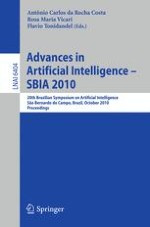2010 | Book
Advances in Artificial Intelligence – SBIA 2010
20th Brazilian Symposium on Artificial Intelligence, São Bernardo do Campo, Brazil, October 23-28, 2010. Proceedings
Editors: Antônio Carlos da Rocha Costa, Rosa Maria Vicari, Flavio Tonidandel
Publisher: Springer Berlin Heidelberg
Book Series : Lecture Notes in Computer Science
